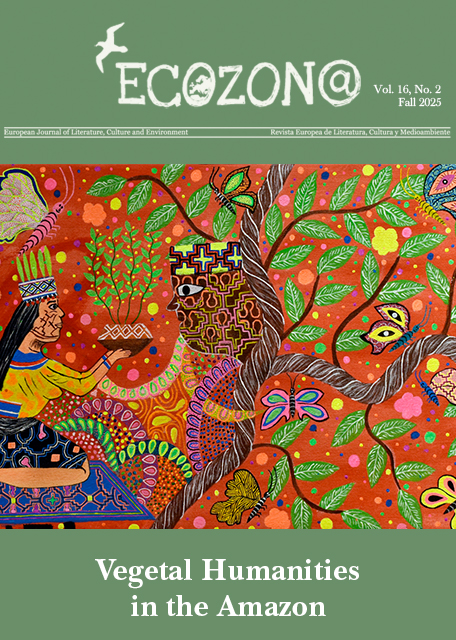<b>Slow Pilgrimage Ecopoetics</b> // La eco-poética del lento peregrinaje
DOI:
https://doi.org/10.37536/ECOZONA.2019.10.1.2527Keywords:
Pilgrimage, vernacular, slow ecopoetics, slow walking, landscape, textscape, contingency, medieval poetry, topopetics // Peregrinaje, vernáculo, eco-poética lenta, andar lento, paisaje, espacio textual, contingencia, poesía medieval, “topo-poética”Abstract
To show the intellectual roots of environmental citizenship, this essay transverses literary and ecological paths by focusing on medieval pilgrimage poems. While design seems integral to the concept of pilgrimage—wayfaring from one’s home to a sacred shrine—in actuality pilgrims not infrequently wandered from the official path. Contingency, rather than randomness, acts as a dynamic agent in affecting the meanderings of the pilgim-walker.
Pilgrimage practice entailed reading the landscape through slow walking. Slow pilgrimage manifests itself in major ways: the slow change in the vernacular language of fourteenth-century pilgrimage poems; the slow amendment pilgrimage is meant to spark spiritually; the slow somatic travail on the road itself; and the act of slowly reading as a form of textual wayfinding. The pilgrimage road, which amends over time, itself works within a diverse ecotone, replete with various pilgrims and pilgrimage works.
Literary pilgrimage poems self-consciously commit themselves to promoting the vernacular. The ecopoetics of a specific “landguage,” the living and resilient vernacular used by medieval pilgrimage writers, sparks amendment—the spiritual change pilgrimage was meant to kindle. Amendment recurs thematically, indicating material change in the actual path walked on by historical pilgrims.
Pilgrim readers undertook textual wayfaring, as do pilgrim-writers through variant texts amended by the poet himself. A strategy of slow ecopoetics authorizes the reader to co-perform the text, making author, reader, and text all kin. Just as the pilgrim presses ahead through a new space, creating the “edge effect” with each step, the pilgrim reader advances alongside the writer, co-creating a resilient literary work.
Resumen
Analizando los poemas medievales del siglo XIV relacionados con la peregrinación y comparando estos con otros textos más contemporáneos, este ensayo explora cómo los elementos inherentes a la eco-poética del peregrinaje oscilan entre lo diseñado y lo casual, tanto a nivel literal como literario. Pese a que su construcción se vehicula a través del concepto de la peregrinación, con elementos temáticos basados en el viaje desde el hogar a un santuario sagrado, lo cierto es que los peregrinos frecuentemente se desviaban. La contingencia, en lugar de la casualidad, funciona como un agente dinámico que afecta a los desvíos del caminante-peregrino.
El lento andar de los peregrinos contribuyó a una eco-poética de la lentitud: el lento ejercicio de seguir el camino; el lento cambio en la lengua vernácula que se empleaba para articular la poesía de la peregrinación; la lenta transformación espiritual provocada, idóneamente, por los actos de peregrinar, caminar, o leer; y la lectura mesurada en sí hecha como forma de un lento peregrinaje.
La enmienda se repite temáticamente en estos textos como concepto y término indicando cambios materiales, espirituales, lingüísticos, y poéticos—los caminos materiales modificados por los peregrinos históricos que los pisaban y seguían. Estas modificaciones corresponden de forma análoga al espectro literario, donde algunas versiones rivales de los poemas medievales sobre la peregrinación eran enmendados y editados por sus autores. Los poemas literarios de peregrinación promueven conscientemente lo vernáculo. La eco-poética de una lengua vernácula viva, o la “topo-poética”, usada por los autores medievales es lo que motiva el cambio espiritual que pretende provocar la peregrinación.
Los lectores-peregrinos emprendían un deambular textual tal como hacían los autores-peregrinos por medio de los textos variados que el propio poeta modificaba. Una de las estrategias de la eco-poética lenta es permitir que el lector coopere en la interpretación del texto, avanzando así junto al autor para crear una obra literaria que responda a un público heterogéneo. Como resultado del no ser maestros del diseño sino seres errantes y contingentes del medio ambiente y de la poesía, los peregrinos—históricos y literarios—contribuyen a la existencia de una adaptabilidad vibrante, como lo ejemplifica la lenta eco-poética de la peregrinación.
Downloads
Downloads
Additional Files
Published
Issue
Section
License
Authors who publish with this journal agree to the following terms:
a) Authors retain copyright and grant the journal right of first publication with the work simultaneously licensed under a Creative Commons Attribution License that allows others to share the work with an acknowledgement of the work's authorship and initial publication in this journal (CC BY-NC for articles and CC BY-NC-ND for creative work, unless author requests otherwise.
b) Authors are able to enter into separate, additional contractual arrangements for the non-exclusive distribution of the journal's published version of the work (e.g., post it to an institutional repository or publish it in a book), with an acknowledgement of its initial publication in this journal.
c) Authors are permitted and encouraged to post their work online (e.g., in institutional repositories or on their website) prior to and during the submission process, as it can lead to productive exchanges, as well as earlier and greater citation of published work (See The Effect of Open Access).










